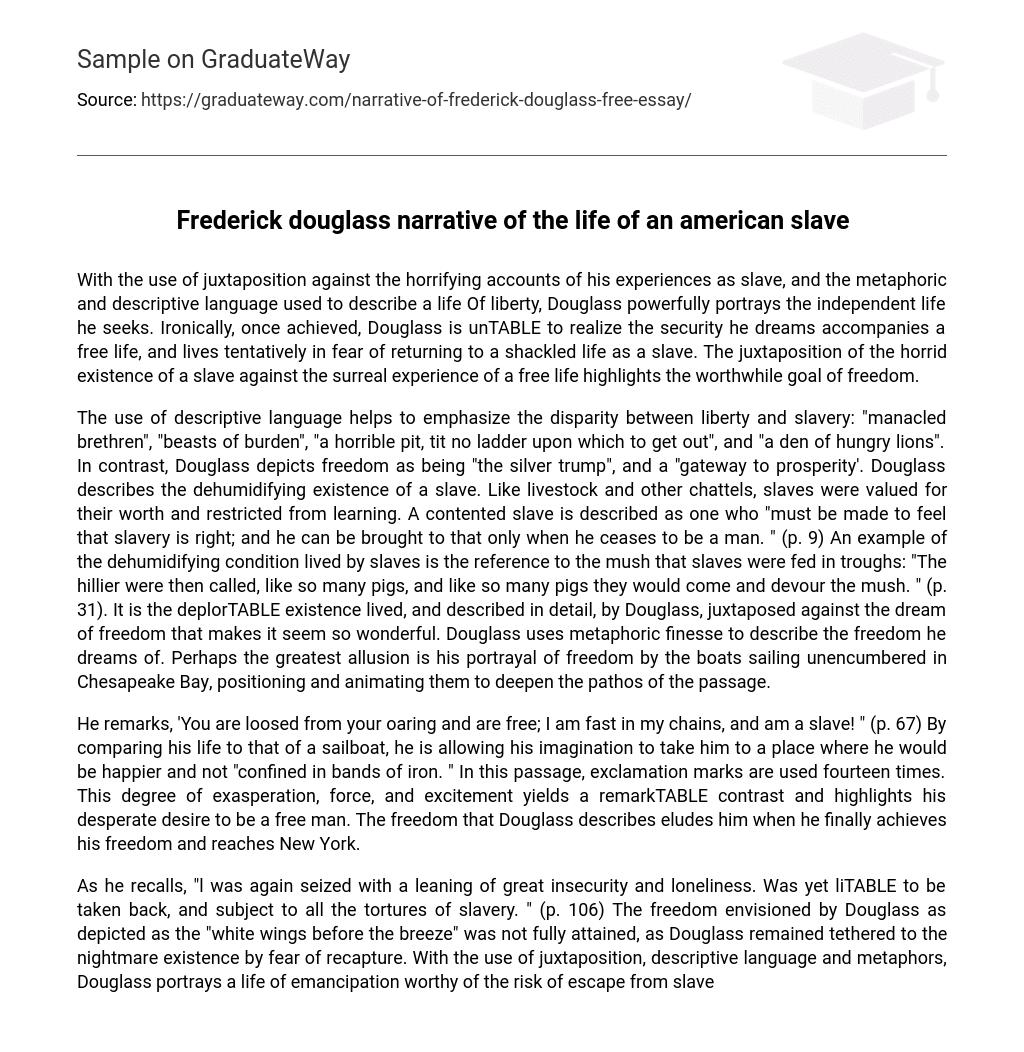With the use of juxtaposition against the horrifying accounts of his experiences as slave, and the metaphoric and descriptive language used to describe a life Of liberty, Douglass powerfully portrays the independent life he seeks. Ironically, once achieved, Douglass is unTABLE to realize the security he dreams accompanies a free life, and lives tentatively in fear of returning to a shackled life as a slave. The juxtaposition of the horrid existence of a slave against the surreal experience of a free life highlights the worthwhile goal of freedom.
The use of descriptive language helps to emphasize the disparity between liberty and slavery: “manacled brethren”, “beasts of burden”, “a horrible pit, tit no ladder upon which to get out”, and “a den of hungry lions”. In contrast, Douglass depicts freedom as being “the silver trump”, and a “gateway to prosperity’. Douglass describes the dehumidifying existence of a slave. Like livestock and other chattels, slaves were valued for their worth and restricted from learning. A contented slave is described as one who “must be made to feel that slavery is right; and he can be brought to that only when he ceases to be a man. ” (p. 9) An example of the dehumidifying condition lived by slaves is the reference to the mush that slaves were fed in troughs: “The hillier were then called, like so many pigs, and like so many pigs they would come and devour the mush. ” (p. 31). It is the deplorTABLE existence lived, and described in detail, by Douglass, juxtaposed against the dream of freedom that makes it seem so wonderful. Douglass uses metaphoric finesse to describe the freedom he dreams of. Perhaps the greatest allusion is his portrayal of freedom by the boats sailing unencumbered in Chesapeake Bay, positioning and animating them to deepen the pathos of the passage.
He remarks, ‘You are loosed from your oaring and are free; I am fast in my chains, and am a slave! ” (p. 67) By comparing his life to that of a sailboat, he is allowing his imagination to take him to a place where he would be happier and not “confined in bands of iron. ” In this passage, exclamation marks are used fourteen times. This degree of exasperation, force, and excitement yields a remarkTABLE contrast and highlights his desperate desire to be a free man. The freedom that Douglass describes eludes him when he finally achieves his freedom and reaches New York.
As he recalls, “l was again seized with a leaning of great insecurity and loneliness. Was yet liTABLE to be taken back, and subject to all the tortures of slavery. ” (p. 106) The freedom envisioned by Douglass as depicted as the “white wings before the breeze” was not fully attained, as Douglass remained tethered to the nightmare existence by fear of recapture. With the use of juxtaposition, descriptive language and metaphors, Douglass portrays a life of emancipation worthy of the risk of escape from slavery. However, once one has lived through such a horrid experience, it may be that true freedom, no matter how it is construed, is illusive.





